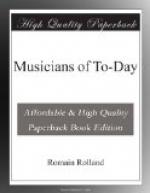The Lamoureux Concerts had served their purpose, and, in their turn, their heroic mission came to an end. They had forced Wagner on Paris; and Paris, as always, had overshot the mark, and could swear by no one but Wagner. French musicians were translating Gounod’s or Massenet’s ideas into Wagner’s style; Parisian critics repeated Wagner’s theories at random, whether they understood them or not—generally when they did not understand them. A reaction was inevitable directly Paris was well saturated with Wagner; and it came about in 1890, among a chosen few, some of whom had been, and were even still, under Wagner’s influence. It was at first only a mild reaction, and showed itself in a return to the classics of the past and to the great primitives in music.
There had been several attempts in this direction before, but none of them had succeeded in making any impression on the mass of the public. In 1843, Joseph Napoleon Ney, Prince of Moszkowa, founded in Paris a society for the performance of religious and classical vocal music. This society, which the Prince himself conducted in his own house, set itself to perform the vocal works of the sixteenth and seventeenth centuries.[221]
[Footnote 221: It published, in eleven volumes, the ancient works that it performed. Before this experiment there had been the Concerts historiques de Fetis, preceded by lectures, which were inaugurated in 1832, and failed; and these were followed by Amedee Mereaux’s Concerts historiques in 1842-1844.]
In 1853, Louis Niedermeyer founded in Paris an Ecole de musique religieuse et classique, which strove “to form singers, organists, choir-masters, and composers of music, by the study of the classic works of the great masters of the fifteenth, sixteenth, and seventeenth centuries.” This school, subsidised by the State, was a nursery for some real musicians. It reckoned among its pupils some noted composers, conductors, organists, and historians; among others, M. Gabriel Faure, M. Andre Messager, M. Eugene Gigout, and M. Henry Expert. M. Saint-Saens was a professor there, and became its president. Nearly five hundred organists, choir-masters, and professors of music of the Conservatoire and other French colleges were trained there. But this school, serious in intention, and a refuge for the classic spirit in the midst of the prevailing bad taste, did not trouble itself about influencing the public, and, in fact, almost ignored it.
Lamoureux attempted in 1873 to perform the great choral works of Bach and Haendel; and in 1878 the celebrated French organist, M. Alexandre Guilmant, ventured to give concerts at the Trocadero for the organ and orchestra, which were devoted to religious music of the seventeenth and eighteenth centuries. But the deplorable acoustics of the concert-room had a prejudicial effect on the works that were performed there; and the public did not respond very warmly to M. Guilmant’s efforts, and seemed from the first only to find an historical interest in the masterpieces, and to miss their depth and life altogether.




